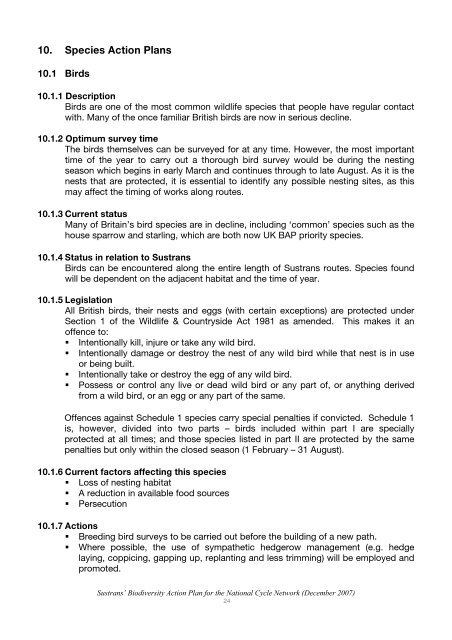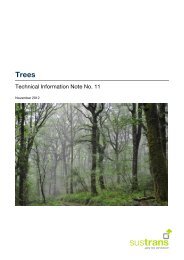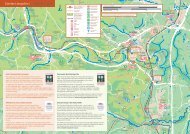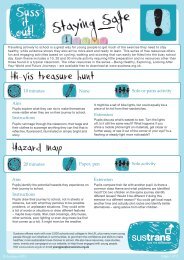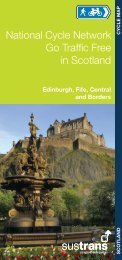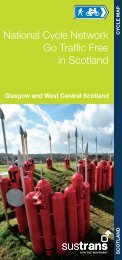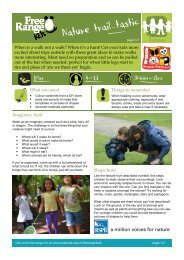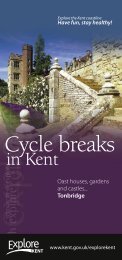Biodiversity Action Plan for the National Cycle Network ... - Sustrans
Biodiversity Action Plan for the National Cycle Network ... - Sustrans
Biodiversity Action Plan for the National Cycle Network ... - Sustrans
Create successful ePaper yourself
Turn your PDF publications into a flip-book with our unique Google optimized e-Paper software.
10. Species <strong>Action</strong> <strong>Plan</strong>s<br />
10.1 Birds<br />
10.1.1 Description<br />
Birds are one of <strong>the</strong> most common wildlife species that people have regular contact<br />
with. Many of <strong>the</strong> once familiar British birds are now in serious decline.<br />
10.1.2 Optimum survey time<br />
The birds <strong>the</strong>mselves can be surveyed <strong>for</strong> at any time. However, <strong>the</strong> most important<br />
time of <strong>the</strong> year to carry out a thorough bird survey would be during <strong>the</strong> nesting<br />
season which begins in early March and continues through to late August. As it is <strong>the</strong><br />
nests that are protected, it is essential to identify any possible nesting sites, as this<br />
may affect <strong>the</strong> timing of works along routes.<br />
10.1.3 Current status<br />
Many of Britain’s bird species are in decline, including ‘common’ species such as <strong>the</strong><br />
house sparrow and starling, which are both now UK BAP priority species.<br />
10.1.4 Status in relation to <strong>Sustrans</strong><br />
Birds can be encountered along <strong>the</strong> entire length of <strong>Sustrans</strong> routes. Species found<br />
will be dependent on <strong>the</strong> adjacent habitat and <strong>the</strong> time of year.<br />
10.1.5 Legislation<br />
All British birds, <strong>the</strong>ir nests and eggs (with certain exceptions) are protected under<br />
Section 1 of <strong>the</strong> Wildlife & Countryside Act 1981 as amended. This makes it an<br />
offence to:<br />
Intentionally kill, injure or take any wild bird.<br />
Intentionally damage or destroy <strong>the</strong> nest of any wild bird while that nest is in use<br />
or being built.<br />
<br />
<br />
Intentionally take or destroy <strong>the</strong> egg of any wild bird.<br />
Possess or control any live or dead wild bird or any part of, or anything derived<br />
from a wild bird, or an egg or any part of <strong>the</strong> same.<br />
Offences against Schedule 1 species carry special penalties if convicted. Schedule 1<br />
is, however, divided into two parts – birds included within part I are specially<br />
protected at all times; and those species listed in part II are protected by <strong>the</strong> same<br />
penalties but only within <strong>the</strong> closed season (1 February – 31 August).<br />
10.1.6 Current factors affecting this species<br />
Loss of nesting habitat<br />
A reduction in available food sources<br />
Persecution<br />
10.1.7 <strong>Action</strong>s<br />
Breeding bird surveys to be carried out be<strong>for</strong>e <strong>the</strong> building of a new path.<br />
Where possible, <strong>the</strong> use of sympa<strong>the</strong>tic hedgerow management (e.g. hedge<br />
laying, coppicing, gapping up, replanting and less trimming) will be employed and<br />
promoted.<br />
<strong>Sustrans</strong>’ <strong>Biodiversity</strong> <strong>Action</strong> <strong>Plan</strong> <strong>for</strong> <strong>the</strong> <strong>National</strong> <strong>Cycle</strong> <strong>Network</strong> (December 2007)<br />
24


